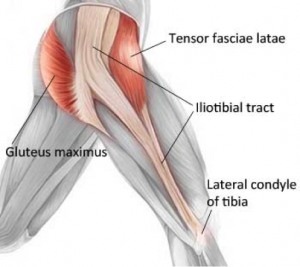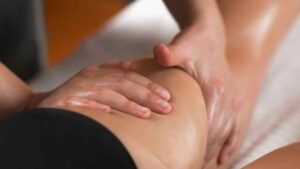The ITB – What is it ? Why does it hurt ? How to treat it!
Words by Remedial Therapist Dan Collins (Dip Remedial Massage)
The Iliotibial Band (ITB) has a poor reputation in sports and sports medicine. Mention your ITB and knowing nods and shakes of the head abound. The ITB is often associated with sports injuries and problems such as iliotibial band friction syndrome and anterior knee pain: and we all know…it hurts !
The ITB is, however, connective tissue, it doesn’t contract, or relax and you can’t directly strengthen it or lengthen it.
So what it the ITB ?
The ITB is actually a thickening of the lateral (outer) soft tissue that envelops the entire upper leg. The thickened band is called the ilio-tibial band (ITB). The muscles that insert into the proximal (upper) portion of this band are the Tensor Fascia Latae and a portion of the Gluteus Maximus and Gluteus Medius muscles. At its lower section the ITB splits medially into the ilio-patellar band and laterallyinto the iliotibial tract. The ITB is also anchored to the femur (thigh bone) via the intermuscular septum (tissue between the lateral quads and the hamstrings).

Iliotibial band anatomy:
So, basically, the ITB is a passive structure that is influenced by the muscles around the region – the TFL and Glute Max muscles that attach to it proximally, and the quads and hamstrings that can pull and tug on the fascia latae which in turn can create stress and tension on the ITB. Weakness and/or asymmetry in any or all of these muscles, combines with repetition (eg: running and cycling) can contribute to ITB issues.
The most common treatments for “tight ITB’s” is usually massage, dry needling and using a foam roller (ouch !!!). These treatments will often work; however the main reason for this improvement is due to reducing tone/tightness in these adjacent muscles the contribute to ITB tension and not by stretching or releasing the ITB itself: remember the ITB is connective tissue that can’t really lengthen (0.2% max).
In the end weak muscles get tight – so the main issue is usually strength defecit, sometimes biomechanical, sometimes overuse, sometimes a combination, rarely flexibility. So here are some basic self help tips for treating your ITB Syndrome.
 *Strengthen your hip abductors (gluteal muscles especially the glutes medius).
*Strengthen your hip abductors (gluteal muscles especially the glutes medius).
*Side Stretching
*Regular remedial massage for those tired and tight muscles
*Gentle foam rolling (not too hard and not too painful)
*Avoid crowned surfaces or too much track running
*Examine your training regimen
*Check your bike set up or get a professional bike fit
Here’s to a happier ITB !
References:
Randall Cooper – Sports Physio; Melbourne. “The Ilio Tibial Band and it’s treatment”.
Stephen M. Pribut, D.P.M. ITB Syndrome: “Cause, Cure and Your Core”
Brian Fullem, D.P.M. “Treating ITBS”

































